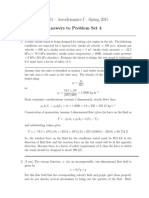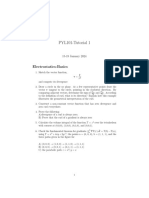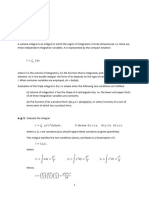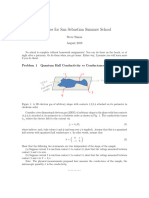Electric Field of Distribution of Charge
Uploaded by
Bushra ArshadCopyright:
Available Formats
Electric Field of Distribution of Charge
Uploaded by
Bushra ArshadOriginal Description:
Original Title
Copyright
Available Formats
Share this document
Did you find this document useful?
Is this content inappropriate?
Copyright:
Available Formats
Electric Field of Distribution of Charge
Uploaded by
Bushra ArshadCopyright:
Available Formats
Electric Field:
The electric field at a point is defined operationally as; “The limit of the force on a
test charge placed at the point to the charge of the rest charge.”
In a vector notation, the definition of ⃗E becomes,
⃗Fq
E = lim
⃗
∆q→ 0 q
Where, the limit being taken as the magnitude of the test charge goes to zero.
The limiting process is included in the definition of ⃗E to ensure that the test
charge does not effect the charge distribution that produces ⃗E
Electric Field of distribution of charge:
Let the charge distribution consist of ‘N’ point charges q 1 , q 2 , … … . qn
located at the points ⃗r1 , ⃗
r 2 … .. ⃗
rn respectively and a surface distribution
characterized by the surface charge density σ ( r⃗ ' ) on the surface ‘S’ and a volume
distribution of charge specified by the charge density σ ( r⃗ ' ) in the volume ‘V’
bounded by the surface ‘S’. If test charge ‘q’ is located at the point it
experiences a force ‘F’ given by
q ( ⃗r −⃗r i ) q
❑
( r⃗ −⃗r ' ) ' ' q ❑ ( r⃗ −⃗r ' ) ' '
F=
⃗ ∑ i N q 3
+ ∫ 3
σ ( r⃗ ) dv + ∫ ρ ( ⃗r ) da
4 π ϵo ⃗
r=¿1 ¿ |r⃗ −⃗r i| 4 π ϵ o v |r⃗−⃗r '| 4 π ϵ o s |⃗r −⃗r '|3
Due to given charge distribution. The electric field at r⃗ is the limit of the ratio of
this force to the test charge since ratio is independent of ‘q’, the electric field at r⃗
is just
1 ( ⃗r −⃗r i ) 1
❑
( ⃗r −⃗r ' ) ' ' 1 ❑ ( r⃗ −⃗r ' ) ' '
∑ i N q 3
+ ∫ 3
σ ( r⃗ ) dv + ∫ ρ ( ⃗r ) da
4 π ϵo ⃗
r=¿1 ¿ |r⃗ −⃗r i| 4 π ϵ o v |r⃗−⃗r '| 4 π ϵ o s |⃗r −⃗r '|3
The Electrostatic Potential
We know that “If curl of a vector vanishes then the vector may be expressed as
the gradient of a scalar function” i.e.
⃗
∇×⃗
∇ φ=0
Also electric field of charges in volume charge distribution ρ ( r⃗ ' ) in volume ‘v’
bounded by the surface ‘S’ having surface charge distribution σ ( r⃗ ' ) given as,
' 1
❑
( r⃗ −r⃗' ) ' ' 1 ❑ ( r⃗− ⃗r ' ) ' '
E ( r⃗ )=
⃗ ∫ ρ ( ⃗r ) dv + ∫ σ ( ⃗r ) ds
4 π ϵ o v |r⃗ −⃗r '|3
' 4 π ϵ o s |⃗r −⃗r '|3 '
Implies this criteria. Therefore by taking curl of above equation involves
differentiation w.r.t This variable appears in Equation (2) only in the functions of
( ⃗r −r⃗' )
the form and hence we can show the function of this form ' 3
has curl So,
|r⃗ −⃗r |
( ⃗r −r⃗' ) 1 1
Curl =grad × ( r⃗ −⃗r ' ) + curl ( ⃗r −⃗r ' )
' 3 ' 3 ' 3
|r⃗ −⃗r | |r⃗ −⃗r | |⃗r −⃗r |
(⃗
∇−φ ⃗
F)
1 ∂ ∂ ∂ −3
grad
|r⃗ −⃗r | ( '
= ∂ x i^ + ∂ y ^j+ ∂ z k^ |⃗r −⃗r |
' 3 )
−3
= ∂ i^ + ∂ ^j+ ∂ k^ [|r⃗ −⃗r '| ]
2 2
(∂x ∂y ∂z )
−3
= ∂ i+
^ ∂ ^j+ ∂ k^ [ ( x−x ' )2+ ( y − y ' )2+ ( z−z ' )2 ] 2
(∂x )
∂y ∂z
( −32 ) 2( x−x ' ) i^ +
( −32 ) 2 ( y− y ' ) ^j +
( −32 )2 ( z−z ' ) k^
5 5 5
2 2 2 2 2 2 2 2 2 2 2 2
[ ( x−x ' ) + ( y − y ' ) + ( z−z ' ) ] [ ( x −x ' ) + ( y− y ' ) + ( z −z ' ) ] [ ( x−x ' ) + ( y− y ' ) + ( z−z ' ) ]
^ ( y− y ' ) ^j+ ( z−z ' ) k^ ]
−3 [ ( x−x ' ) i+
= 5
[ ( x−x ' )2+ ( y − y ' )2+ ( z−z ' )2 ]2
1 −3 ( ⃗r −⃗
r ')
grad ' 3 = 5
|r⃗ −⃗r | |r⃗ −r⃗'|
Equation (3)⇒
( ⃗r −r⃗' ) 1 −3 ( r⃗ −⃗ r ')
Curl
|r⃗ −⃗
3
=
r '| |r⃗ −⃗r '|
3
( 0 )−
[
|⃗r − ⃗r '|
5
]
[ r⃗ −⃗
r ']
But ( r⃗ −⃗
r ' ) × ( ⃗r −r⃗' )=0 ∴ (⃗
A×⃗
A ' )=0
( ⃗r −r⃗' )
Curl 3
=0
|r⃗ −⃗r '|
It means that;
⃗ E (⃗
∇×⃗ r ' )=0 (4)
Thus we can write from equation (1) & (4)
E ( r⃗' )=−⃗
⃗ ∇ϕ(⃗
r' ) (5)
Where ϕ ( r⃗' )the electrostatic potential & -ve sign is by convention. Equation (5)
represent that a scalar function exists whose gradient is electric field.
You might also like
- 1.6. Vector Fields (Continued) 1.6.2. The Divergence of A Vector FieldNo ratings yet1.6. Vector Fields (Continued) 1.6.2. The Divergence of A Vector Field6 pages
- AE 301 - Aerodynamics I - Spring 2015 Answers To Problem Set 4No ratings yetAE 301 - Aerodynamics I - Spring 2015 Answers To Problem Set 47 pages
- L3a - Directional Derivatives, Tangent Plane & Vector OperatorsNo ratings yetL3a - Directional Derivatives, Tangent Plane & Vector Operators14 pages
- Subvarieties of General Hypersurfaces in Projective Space: Theorem 1No ratings yetSubvarieties of General Hypersurfaces in Projective Space: Theorem 134 pages
- Electromagnetic Theory Notes (June-2024)No ratings yetElectromagnetic Theory Notes (June-2024)18 pages
- PEP 2020 Phase 2 Selection Test 3 - SolutionNo ratings yetPEP 2020 Phase 2 Selection Test 3 - Solution6 pages
- (II) Electric Field of Continuous Charge DistributionNo ratings yet(II) Electric Field of Continuous Charge Distribution5 pages
- ELE 244 Electromagnetics I: Lecture 6: Electrostatics Electric Field & Electric PotentialNo ratings yetELE 244 Electromagnetics I: Lecture 6: Electrostatics Electric Field & Electric Potential48 pages
- 1 Energy in The Electromagnetic Field: 1.1 Electrostatic CaseNo ratings yet1 Energy in The Electromagnetic Field: 1.1 Electrostatic Case13 pages
- Download full Calculus 6th Edition Karl J. Smith ebook all chapters100% (11)Download full Calculus 6th Edition Karl J. Smith ebook all chapters75 pages
- Notes of The Boltzmann Equation by Alberto BressanNo ratings yetNotes of The Boltzmann Equation by Alberto Bressan28 pages
- Chapter 2 Electric Potential and Capacitance NotesNo ratings yetChapter 2 Electric Potential and Capacitance Notes30 pages
- 4 Planes and Lines - Examples and ExercisesNo ratings yet4 Planes and Lines - Examples and Exercises21 pages
- Understanding Vector Calculus: Practical Development and Solved ProblemsFrom EverandUnderstanding Vector Calculus: Practical Development and Solved ProblemsNo ratings yet
- Civil Engrg Maths 1 Lecture Notes For 2019 - 20No ratings yetCivil Engrg Maths 1 Lecture Notes For 2019 - 20275 pages
- Unit I: Probability and Random VariablesNo ratings yetUnit I: Probability and Random Variables26 pages
- Selected Solutions To Hoffman and Kunze's Linear Algebra Second EditionNo ratings yetSelected Solutions To Hoffman and Kunze's Linear Algebra Second Edition110 pages

























































































